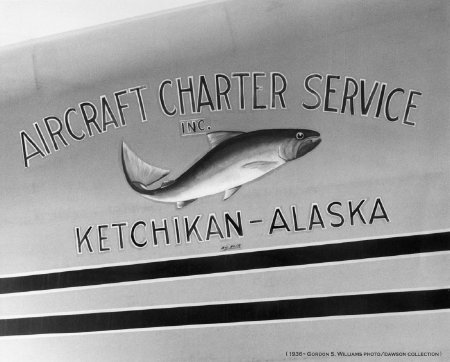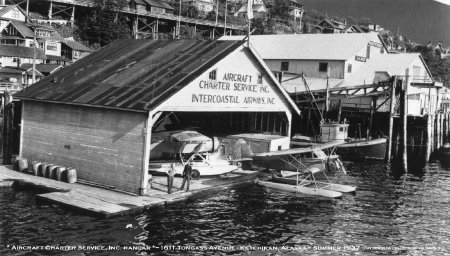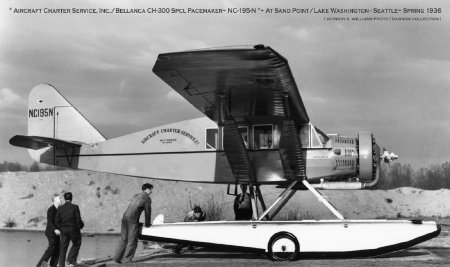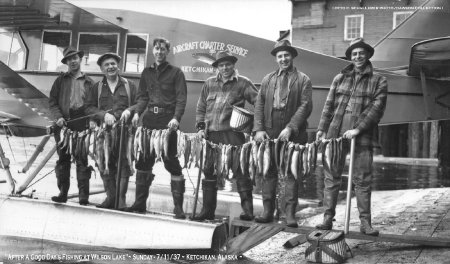Description:
Aircraft Charter Service, 1935-1941
Aircraft Charter Service was co-founded in Ketchikan in 1935 by Alaska cannery baron Nick Bez and owner/pilot Herb Munter. Aircraft Charter Service purchased a single 4-place yellow Model UIC Cabin Waco Seaplane (NC13068) mounted on Edo 38-3430 floats. In 1912, when he was 18, Munter and his brother built the first Seattle made airplane based on a Curtiss Pusher tricycle biplane. They barnstormed around the Pacific Northwest doing exhibition flights. Four years later, Munter became the first employee of The Boeing Airplane Company as its original test pilot. Munter hired Ray Renshaw (ex-Gorst Air Transport) to be Aircraft Charter Service's mechanic and second pilot.
The two flyers arrived in Ketchikan with their Waco on Sunday, May 12, 1935 to launch their new air charter company's seasonal operations. The plane initially worked from a ramp located on City Float, and was immediately in demand. Munter later purchased the large hangar building from the closed Ketchikan municipal hydroplane landing port facility located at North Tongass Highway and Shoreline Drive, which he converted into a floating hangar and relocated downtown at 1611 Tongass Avenue. Renshaw resided up in the small hangar loft apartment to help conveniently maintain the aircraft. After a very successful summer of commercial flying all around Ketchikan and throughout the Southeast Panhandle, they flew the Waco back to Seattle on September 17, 1935 to end their inaugural season. Munter then sold the Waco to Don Glass in Juneau.
For the next season, Herb Munter bought a 6-place 1931 Bellanca CH-300 Special Pacemaker (NC195N) mounted on Edo K-4650 floats, which he equipped with a two-way radio. Munter and Renshaw arrived back in Ketchikan on May 8, 1936 in time for the start of the summer fishing season. In July 1936, Aircraft Charter Service found itself in direct competition with a new Ketchikan based company, Ellis Air Transport, headed by experienced veteran Alaska Panhandle aviator Bob Ellis flying his brand new red Cabin Waco YKS-6 seaplane from his floating hangar. The two rival outfits aggressively vied against each other to scoop up business, in a burgeoning market that was now strong enough to support them both year-round, with lucrative regional charters to be had to keep things vibrant. Airplanes were coming and going between towns on a regular basis as commercial air taxis began augmenting their fleets in response to growing demand. In Juneau, Shell Simmons founded Alaska Air Transport in 1936. His competitor Alex Holden established Marine Airways in 1937.
In 1937, Munter bought a 4-place red Stinson JR-SR Reliant (NC13478) on Edo 3430 floats for Renshaw to fly, while he continued piloting Aircraft Charter Service's Bellanca Pacemaker. Aircraft Charter Service expanded to include regular scheduled passenger airline services with the addition of Intercoastal Airways in July 1937. The twice-weekly Ketchikan-Wrangell-Petersburg-Juneau scheduled run departed from Ketchikan at 9 a.m. every Monday and Thursday. In 1938, there was much discussion about the idea of establishing a new wheel plane airport for Ketchikan at nearby Bostwick Inlet on adjacent Gravina Island. On June 1, 1938, Herb Munter went public to discourage such a move, believing it would hurt the local seaplane companies. Ellis upped the ante in 1939, with the addition of a large 6-place Bellanca Senior Pacemaker floatplane. In a June 21, 1940 newspaper ad, Aircraft Charter Service noted "Cabin Seaplanes Available for Charter: 4-place - $35.00/hr., 6-place - $45.00/hr."
In the spring of 1941, to capitalize on the new U.S. government subsidized Civilian Pilot Training Program, Munter bought a 1940 2-place Aeronca S-65CA Chief (NC23505) on floats, and had a second floating hangar built. A number of noted Ketchikan locals earned their private pilots licenses while taking flying lessons from Munter, including Rodger Elliott, Wes Sande, and John Minnich. Hugh Ramsdell served as a mechanic for Aircraft Charter Service at that time, and all later worked for Ellis Air Lines (including Ray Renshaw).
Right after Ellis Air Transport added a second Cabin Waco in March 1941, both Munter and Ellis found they'd reached the point to where neither was making any profit trying to be competitive. A mutual decision was made to try combining their efforts through the formation of a joint operation instead. Initially calling themselves "The Ellis-Munter Air Service," they changed the name to "Alaska Airlines" in the late summer of 1941. The merger experiment didn't pan out and the only remaining option was for one of them to buy out the other. On September 1, 1941, Ellis Air Transport bought Aircraft Charter Service's assets, acquiring four more airplanes and two hangars in the process. With the start of the U.S. involvement in WWII on December 7, 1941, aviators and airplanes in Alaska were promptly conscripted by the military to be pressed into service for the war effort. Both Munter and Ellis became U.S. Navy pilot officers and were stationed in Alaska and the Aleutian Islands.
In 1946, Herb Munter and Nick Bez formed West Coast Airlines in Seattle, which later became part of Air West. Munter retired in 1958, and died May 24, 1970 in Walnut Creek, California at the age of 75.
Aircraft Specifications:
4-place Cabin Waco UIC Biplane/Seaplane on Edo Mod. P-3300 or 38-3430 floats. First Flight: March 1933. 83 built with many variants built from 1931-1942. Construction: Metal tube and wood with fabric covered airframe and wings with aluminum leading edge. Dimensions: Length: 28' 10"; Height: 10' 7"; Upper Wingspan: 33' 3"; Lower Wingspan: 28' 3". Weights: Standard Empty Weight: 2,131 lbs.; Gross Weight: 3,250 lbs.; Useful Load: 1,119 lbs.; Fuel Capacity: 50 gal. Performance: Airspeed: 105 mph cruise, 126 mph max; Service Ceiling: 11,250 ft.; Rate of Climb: 750 ft. per min.; Range: 400 mi. Engine: Air-cooled 7 Cylinder 210 hp Continental R-670. Propeller: Metal 2-Blade Fixed-Pitch.
6-place Bellanca CH-300 Special Pacemaker Seaplane on Edo Mod K-4650 floats. First Flight: 1929. 35 Built. Construction: Metal tube and fabric covered airframe and wings. Dimensions: Length: 27' 9"; Height: 8' 4"; Wingspan: 46' 4". Weights: Standard Empty Weight: 2,275 lbs.; Gross Weight: 4,072 lbs. Performance: Airspeed: 110 mph cruise, 165 mph max; Service Ceiling: 18,000 ft.; Range: 850 mi. Engine: 9 cylinder 330 hp Wright R-975D.
4-place Stinson JR-SR Reliant Seaplane on Edo Mod. P-3300 or 38-3430 floats. First Flight: March 1933. Many variants built. Construction: Metal tube and fabric covered airframe and wings. Dimensions: Length: 27'; Height 8'; Wingspan: 43' 25". Weights: Standard Empty Weight: 2,070 lbs.; Gross Weight: 3,155 lbs.; Useful Load: 1,119 lbs.; Fuel Capacity: 76 gal. Performance: Airspeed: 115 mph cruise; Rate of Climb: 675 ft. per min.; Range: 400 mi. Engine: Air-cooled 7 Cylinder 215 hp Lycoming R-680. Propeller: Metal 2-Blade Fixed-Pitch.
2-place Aeronca S-65CA Super Chief on Edo Mod. 60-1320 floats. First Flight 1937. 655 built from 1936-1949 (all variants). Construction: Metal tube and fabric covered airframe and wings. Dimensions: Length: 21'; Wingspan: 36'. Performance: Airspeed: 100 mph cruise, 109 mph max; Service Ceiling: 15,000 ft.; Range: 400-500 mi.; Rate of Climb: 600 ft. per min. Engine: 65 hp Continental A-658.
Pilots:
Herb Munter and Ray Renshaw.
Mechanics:
Ray Renshaw and Hugh Ramsdell.
The two flyers arrived in Ketchikan with their Waco on Sunday, May 12, 1935 to launch their new air charter company's seasonal operations. The plane initially worked from a ramp located on City Float, and was immediately in demand. Munter later purchased the large hangar building from the closed Ketchikan municipal hydroplane landing port facility located at North Tongass Highway and Shoreline Drive, which he converted into a floating hangar and relocated downtown at 1611 Tongass Avenue. Renshaw resided up in the small hangar loft apartment to help conveniently maintain the aircraft. After a very successful summer of commercial flying all around Ketchikan and throughout the Southeast Panhandle, they flew the Waco back to Seattle on September 17, 1935 to end their inaugural season. Munter then sold the Waco to Don Glass in Juneau.
For the next season, Herb Munter bought a 6-place 1931 Bellanca CH-300 Special Pacemaker (NC195N) mounted on Edo K-4650 floats, which he equipped with a two-way radio. Munter and Renshaw arrived back in Ketchikan on May 8, 1936 in time for the start of the summer fishing season. In July 1936, Aircraft Charter Service found itself in direct competition with a new Ketchikan based company, Ellis Air Transport, headed by experienced veteran Alaska Panhandle aviator Bob Ellis flying his brand new red Cabin Waco YKS-6 seaplane from his floating hangar. The two rival outfits aggressively vied against each other to scoop up business, in a burgeoning market that was now strong enough to support them both year-round, with lucrative regional charters to be had to keep things vibrant. Airplanes were coming and going between towns on a regular basis as commercial air taxis began augmenting their fleets in response to growing demand. In Juneau, Shell Simmons founded Alaska Air Transport in 1936. His competitor Alex Holden established Marine Airways in 1937.
In 1937, Munter bought a 4-place red Stinson JR-SR Reliant (NC13478) on Edo 3430 floats for Renshaw to fly, while he continued piloting Aircraft Charter Service's Bellanca Pacemaker. Aircraft Charter Service expanded to include regular scheduled passenger airline services with the addition of Intercoastal Airways in July 1937. The twice-weekly Ketchikan-Wrangell-Petersburg-Juneau scheduled run departed from Ketchikan at 9 a.m. every Monday and Thursday. In 1938, there was much discussion about the idea of establishing a new wheel plane airport for Ketchikan at nearby Bostwick Inlet on adjacent Gravina Island. On June 1, 1938, Herb Munter went public to discourage such a move, believing it would hurt the local seaplane companies. Ellis upped the ante in 1939, with the addition of a large 6-place Bellanca Senior Pacemaker floatplane. In a June 21, 1940 newspaper ad, Aircraft Charter Service noted "Cabin Seaplanes Available for Charter: 4-place - $35.00/hr., 6-place - $45.00/hr."
In the spring of 1941, to capitalize on the new U.S. government subsidized Civilian Pilot Training Program, Munter bought a 1940 2-place Aeronca S-65CA Chief (NC23505) on floats, and had a second floating hangar built. A number of noted Ketchikan locals earned their private pilots licenses while taking flying lessons from Munter, including Rodger Elliott, Wes Sande, and John Minnich. Hugh Ramsdell served as a mechanic for Aircraft Charter Service at that time, and all later worked for Ellis Air Lines (including Ray Renshaw).
Right after Ellis Air Transport added a second Cabin Waco in March 1941, both Munter and Ellis found they'd reached the point to where neither was making any profit trying to be competitive. A mutual decision was made to try combining their efforts through the formation of a joint operation instead. Initially calling themselves "The Ellis-Munter Air Service," they changed the name to "Alaska Airlines" in the late summer of 1941. The merger experiment didn't pan out and the only remaining option was for one of them to buy out the other. On September 1, 1941, Ellis Air Transport bought Aircraft Charter Service's assets, acquiring four more airplanes and two hangars in the process. With the start of the U.S. involvement in WWII on December 7, 1941, aviators and airplanes in Alaska were promptly conscripted by the military to be pressed into service for the war effort. Both Munter and Ellis became U.S. Navy pilot officers and were stationed in Alaska and the Aleutian Islands.
In 1946, Herb Munter and Nick Bez formed West Coast Airlines in Seattle, which later became part of Air West. Munter retired in 1958, and died May 24, 1970 in Walnut Creek, California at the age of 75.
Aircraft Specifications:
4-place Cabin Waco UIC Biplane/Seaplane on Edo Mod. P-3300 or 38-3430 floats. First Flight: March 1933. 83 built with many variants built from 1931-1942. Construction: Metal tube and wood with fabric covered airframe and wings with aluminum leading edge. Dimensions: Length: 28' 10"; Height: 10' 7"; Upper Wingspan: 33' 3"; Lower Wingspan: 28' 3". Weights: Standard Empty Weight: 2,131 lbs.; Gross Weight: 3,250 lbs.; Useful Load: 1,119 lbs.; Fuel Capacity: 50 gal. Performance: Airspeed: 105 mph cruise, 126 mph max; Service Ceiling: 11,250 ft.; Rate of Climb: 750 ft. per min.; Range: 400 mi. Engine: Air-cooled 7 Cylinder 210 hp Continental R-670. Propeller: Metal 2-Blade Fixed-Pitch.
6-place Bellanca CH-300 Special Pacemaker Seaplane on Edo Mod K-4650 floats. First Flight: 1929. 35 Built. Construction: Metal tube and fabric covered airframe and wings. Dimensions: Length: 27' 9"; Height: 8' 4"; Wingspan: 46' 4". Weights: Standard Empty Weight: 2,275 lbs.; Gross Weight: 4,072 lbs. Performance: Airspeed: 110 mph cruise, 165 mph max; Service Ceiling: 18,000 ft.; Range: 850 mi. Engine: 9 cylinder 330 hp Wright R-975D.
4-place Stinson JR-SR Reliant Seaplane on Edo Mod. P-3300 or 38-3430 floats. First Flight: March 1933. Many variants built. Construction: Metal tube and fabric covered airframe and wings. Dimensions: Length: 27'; Height 8'; Wingspan: 43' 25". Weights: Standard Empty Weight: 2,070 lbs.; Gross Weight: 3,155 lbs.; Useful Load: 1,119 lbs.; Fuel Capacity: 76 gal. Performance: Airspeed: 115 mph cruise; Rate of Climb: 675 ft. per min.; Range: 400 mi. Engine: Air-cooled 7 Cylinder 215 hp Lycoming R-680. Propeller: Metal 2-Blade Fixed-Pitch.
2-place Aeronca S-65CA Super Chief on Edo Mod. 60-1320 floats. First Flight 1937. 655 built from 1936-1949 (all variants). Construction: Metal tube and fabric covered airframe and wings. Dimensions: Length: 21'; Wingspan: 36'. Performance: Airspeed: 100 mph cruise, 109 mph max; Service Ceiling: 15,000 ft.; Range: 400-500 mi.; Rate of Climb: 600 ft. per min. Engine: 65 hp Continental A-658.
Pilots:
Herb Munter and Ray Renshaw.
Mechanics:
Ray Renshaw and Hugh Ramsdell.
Click to Enlarge







